Alpha TRainer 80 HP - ULM
Alpha Trainer's Birth - Innovation - Performance - Cabin Comfort - Instruments - Safety - Dimensions - Materials - Technical Data - Brochure
Introduction
iFly and Pipistrel introduces the economic Alpha Trainer in the Netherlands, Belgium and Luxembourg.
Build on the solid pedigree of our extensive product line-up, the ALPHA TRAINER combines quality with a fantastic price tag. Affordable flying with no performance set-backs is now here!
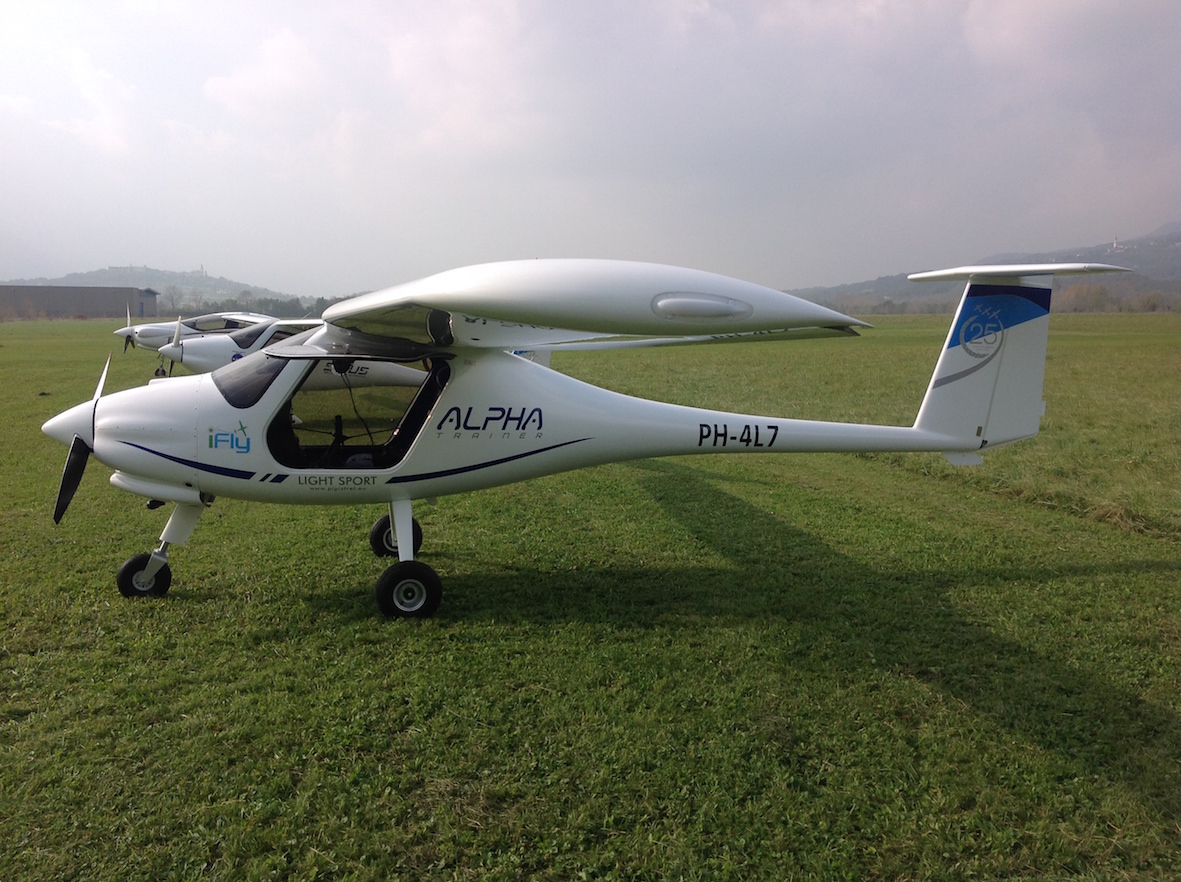
Alpha Trainer's birth
The name “Pipistrel ALPHA Trainer” describes the exact purpose of this exciting new aircraft designed for flying schools. The aircraft has been engineered with the "essence of training" as its primary design goal; training has to start somewhere, just like the alphabet starts with the letter “A” therefore this new aircraft bears the name ALPHA.
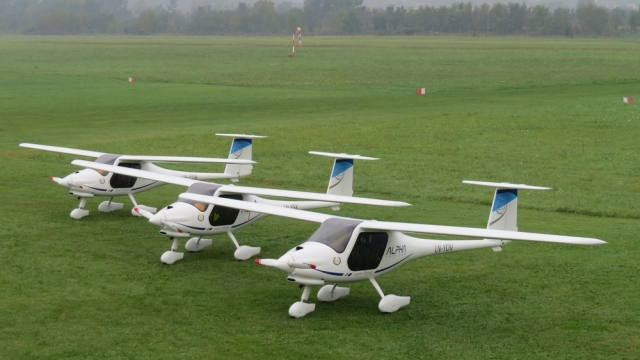
We do not imitate, we innovate!
The times have been changing, but the ailing economy doesn't mean that people need to stop learning to fly. Most aircraft are too expensive for the average person or flight school to purchase, but Pipistrel has developed an entirely new approach to flight training and at a cost nearly half that of our competitors.
The new ALPHA Trainer is packed with some exciting features! Not only it is affordable to purchase, it is also very economical to maintain and fun to fly! In fact, we believe that no other LSA training aircraft offers as low operation costs as the new Pipistrel ALPHA Trainer!
When training meets economy.
Innovation
The Alpha Trainer is designed by applying the most modern design and construction techniques, on top of 20 years of knowledge, experience and excellence in building aircraft.
Here are our ideas what a proper ULM or LSA training airplane should be like. All of them have been incorporated in the ALPHA Trainer:
• It must be strong and easy to fly for beginner students
• It must have benign stall characteristics for the training market with no flying surprises
• It must be affordable and easy to operate, maintain and repair
• It must be capable of doing circuits all day long, in all conditions including excessive heat well above 100°F (37°C)
• It must have good ventilation and heating when required
• It must have approved strobes and lighting
• It must have a quiet cockpit for easy communication between instructor and student
• It must have guaranteed access to reliable spare parts supply to keep the aircraft on the flight line
• It must have reasonable range for cross-country flight training
• It must be easy to service daily and refuel
• It must have a ballistic parachute system
• It must have a durable finish for outdoor storage
• It must have good brakes for the odd ‘urgent occasion’
• It must have dual flight controls, easy and quickly adjustable for different sized people
• It must have an expected long operating life
• It must be tricycle configuration with steerable nose wheel
• It must have easy cockpit access, even for elderly students
• And did we say affordable to purchase and operate?
Economic Performer
What makes the Alpha Trainer and economic performer?
Undercarriage
The main undercarriage, which is made of composite material, has been reinforced to handle the hardest landings even at MTOW, which provides for a full fuel payload of 507 lbs (230 kg). The undercarriage is designed to be strong and durable and capable of accepting hard landings made by student pilots. The new nose leg is 2 inches (5 cm) shorter, lowering the nose and improving the visibility during taxi. Propeller clearance is not sacrificed because the Pipistrel ALPHA Trainer uses a smaller 63” (162 cm) diameter fixed pitch propeller.
Fuel tank
The Pipistrel ALPHA Trainer aircraft has a new central 13.2 US gal (50 l) fuel tank. 13.2 US gal (50 l) does not sound like much when you are talking about conventional aircraft, but Pipistrel aircraft are much more efficient! In reality 13.2 US gal (50 l) is more than enough for the ALPHA Trainer. The fuel tank now has a large opening which means it can be filled directly from fast flowing avgas pumps which are found at the large majority of airfields. The capacity will give the Pipistrel ALPHA Trainer aircraft at least 324 NM (600 km) range 30 minutes reserve at normal cruise speeds of 108 kts (200 km/h). In the training role doing circuits the aircraft will be using less than 2.5 gallons per hour (7.6 liters per hour), effectively giving you 5 hours endurance from just 13.2 US gal (50 l) of fuel.
The engine
The Pipistrel ALPHA Trainer is fitted with the ever reliable Rotax 912 80 hp engine. While some may question whether 80 hp is enough, those familiar with Pipistrel know that our designs maximize performance with the given power. The 80 hp engine powers the Pipistrel ALPHA Trainer to a respectable, Cessna 172 cruise speed of 108 knots (200km/h) and will achieve very short take-off distance and climb rates of over 1000 fpm (5 m/s). Pipistrel believes that the Rotax 80 hp engine is the ideal choice for a training aircraft, it is smooth and reliable, it is frugal with the fuel and the 2000 hour/15 year TBO is achievable.
New wing design
The Pipistrel ALPHA Trainer has a new wing design based on the already successful and proven Pipistrel Virus SW aircraft. With the redesigned wing the aircraft does not require airbrakes to land, further simplifying the cockpit controls for students. The new wings feature redesigned flaperons which now have +25° of flap travel enabling short field landings.
New Propeller
The new propeller for the Pipistrel ALPHA Trainer is Pipistrel's own design, CNC machined in-house. It is manufactured from wood and is then protected with a durable covering including leading edge protection. Being a wooden propeller there is very little vibration which contributes towards the smooth running of the aircraft. A special covering makes the propeller very durable, offering years of use in a normal training environment.
Materials
The Pipistrel ALPHA Trainer is manufactured from state-of-the-art composite materials and has an empty weight of 100 pounds less than most competitors’ aircraft. This, combined with reduced drag, is one of the reasons why the Pipistrel ALPHA Trainer can offer such good performance and economy.
Luggage compartment
The ALPHA Trainer has a luggage rack for storing of tie downs and ropes, water bottles, first aid kit and other accessories. Access to the storage area is through the cockpit seats which fold forward to offer easy and unrestricted access. There are also two large pockets on the sides of the instrument panel, ideal for storing maps and water bottles during flight.
Brakes
The brakes have been redesigned and simplified for the Pipistrel ALPHA Trainer, offering exceptional braking performance even on short airfields. The directly steerable nose wheel can easily turn the aircraft in a very short distance and the brake shoes can be replaced in less than 15 minutes, keeping your maintenance costs down.
Cabin Comfort
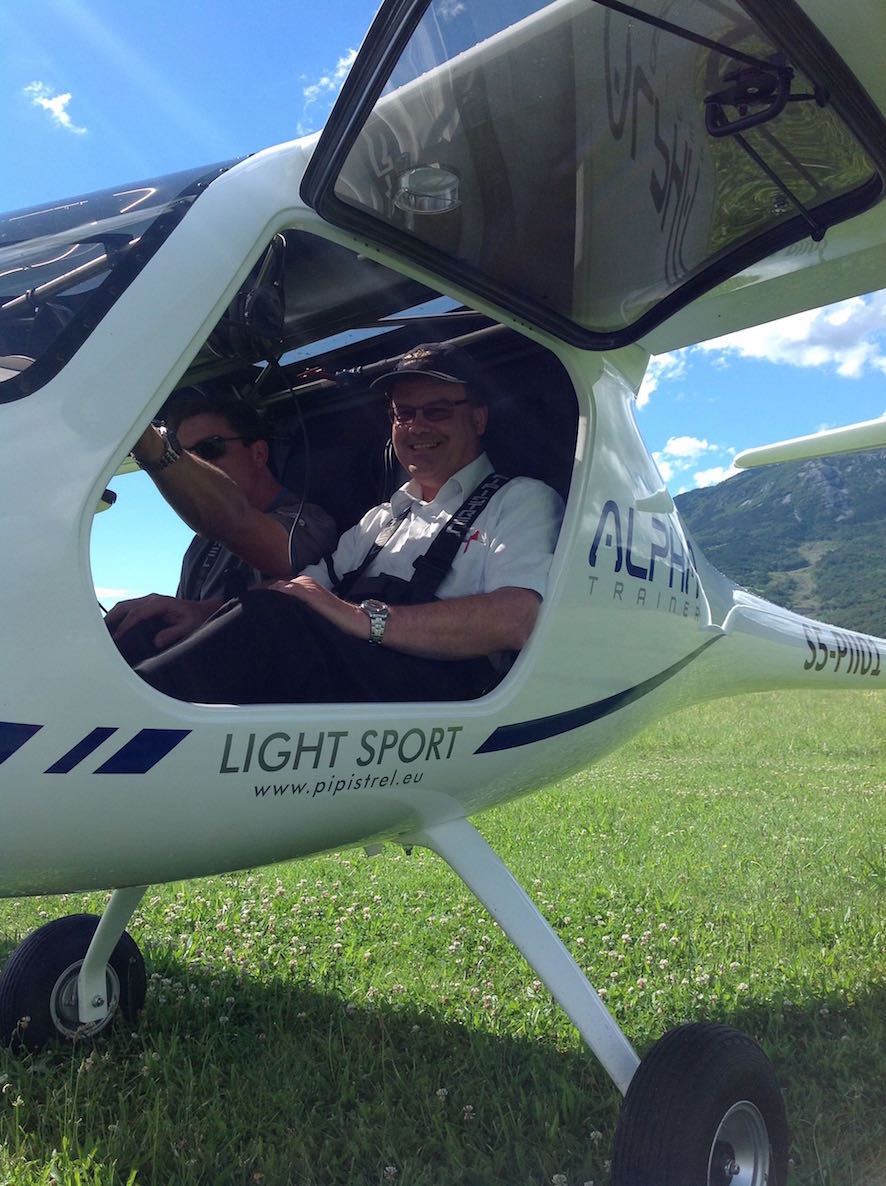 The reinforced safety cockpit with a interior will keep you both comfortable and safe. Although a standard aircraft configuration you still have some options to improve the training experience.
The reinforced safety cockpit with a interior will keep you both comfortable and safe. Although a standard aircraft configuration you still have some options to improve the training experience.
Instruments
During our quarter of century of aircraft building experience we have learned that a training aircraft must have a classic-looking instrument panel, so we have kept this look but modernised the instruments for better visibility and reliability using large and very easy to read 3 1/8” (80 mm) ASI and ALT. The instrument panel is made of carbon fibre with visible-structure and is accommodating a standard selection of modern avionics. The panel can be arranged according to your wishes with assistance of our skilled avionics technicians.
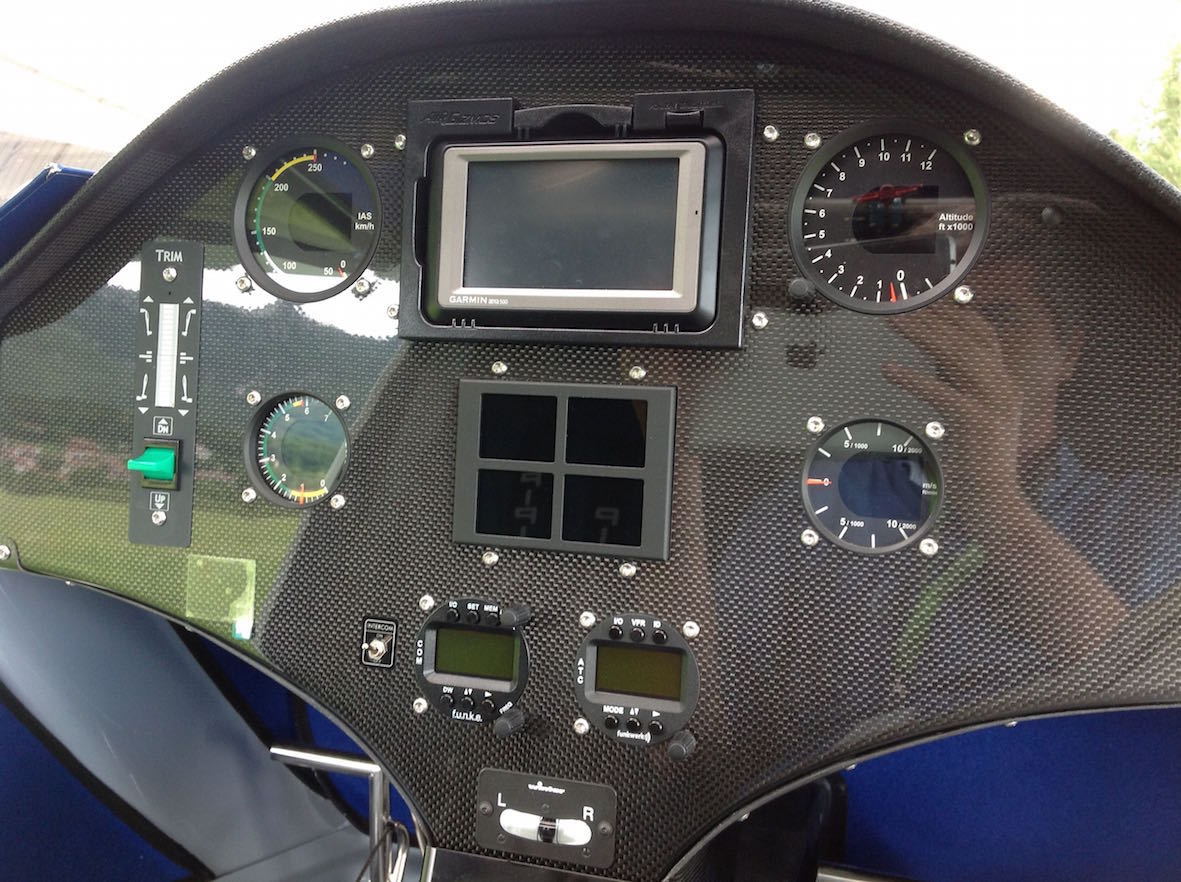
Conventional-looking aircraft instruments are all clearly labelled with the correct colour coded speeds and temperatures in a traditional and familiar training format.
Variometer and engine RPM counter have two separate displays while the other engine parameters are displayed in a common multifunction very bright full-colour display with audio alarms for exceeded values, which significantly increases the safety.
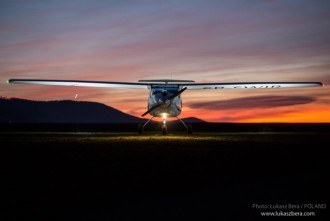 All avionics are well-lit with their own light source which enables good visibility during all kinds of light conditions; equally visible during both day and night flying.
All avionics are well-lit with their own light source which enables good visibility during all kinds of light conditions; equally visible during both day and night flying.
Safety
The Alpha Trainer has the largest flight safety margins in its category and is standard equipped with the total rescue system, deployable even at maximum speeds and close to the terrain.
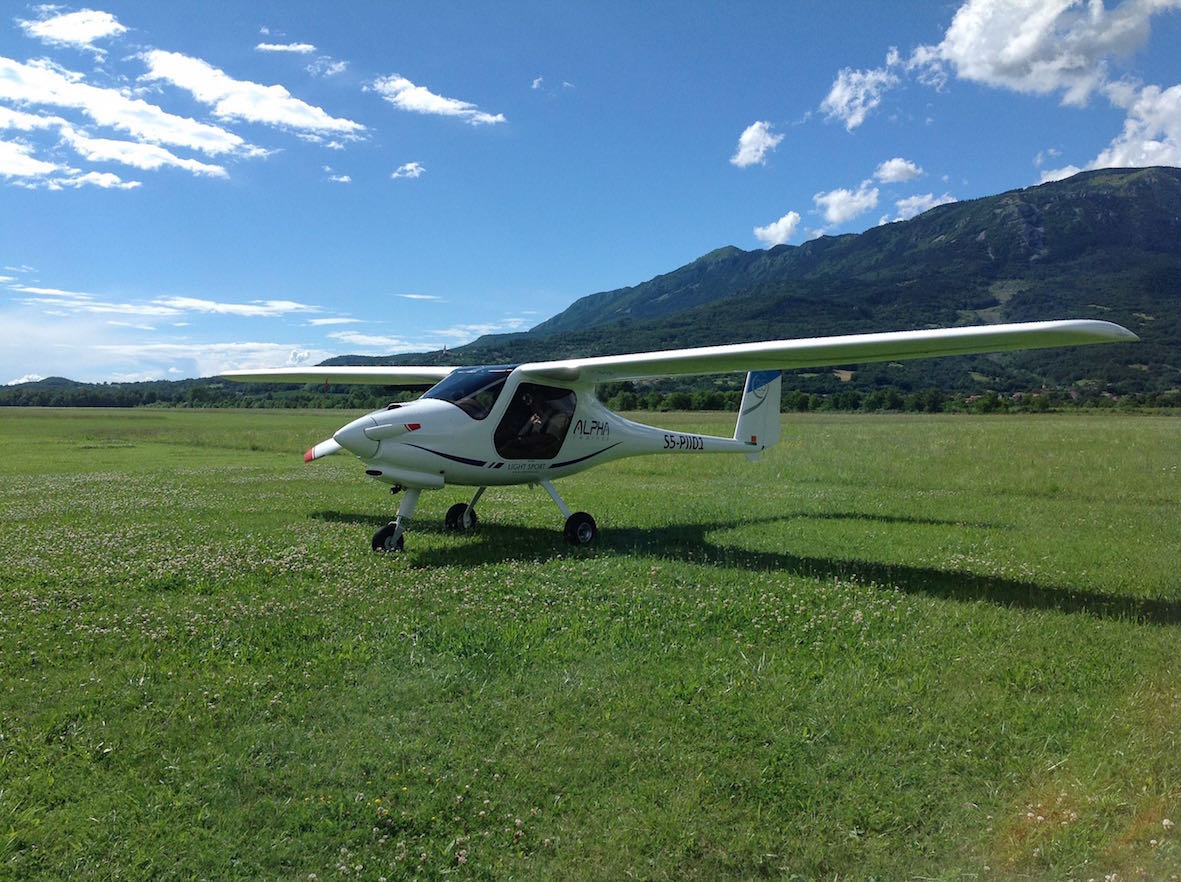
All engineering work and testing of the 10.71-meter Alpha Trainer was carried out at Pipistrel premises in Ajdovšcina, Slovenia under supervision of CAA of Republic of Slovenia. This separates Pipistrel from most other producers, because all design, production and testing is directly monitored by the CAA, ensuring accuracy of data. Before its introduction to the market, more than a year of ground structural and vibration tests went by without a glitch, followed by an extensive flight test programme with more than 100 hours cumulative tests.
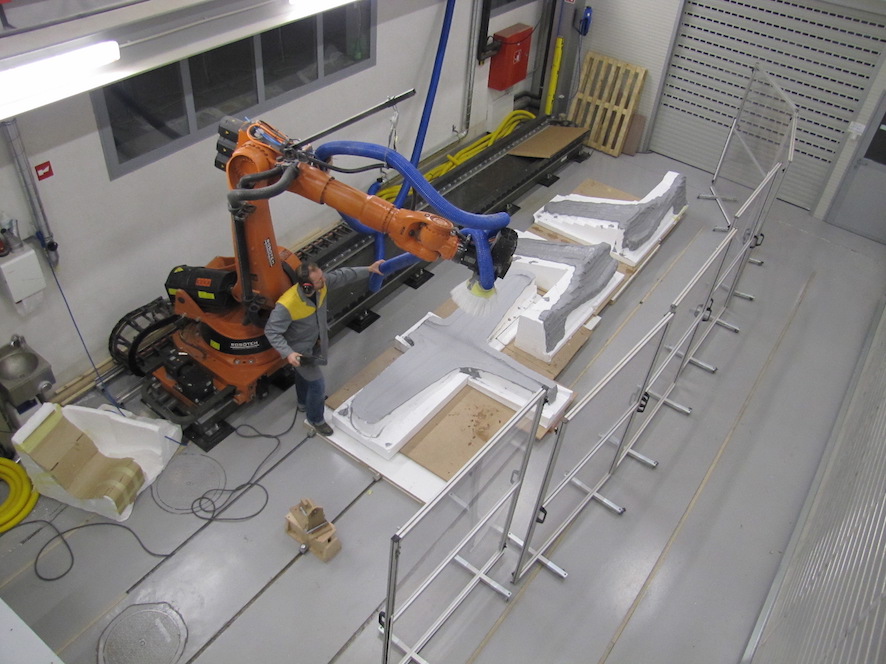
Now, more than one hundred Alpha Trainer aircraft are flying Worldwide, performing flawlessly in the difficult conditions of tropical Thailand, high-elevations of Ecuador and the cold wilderness of Canada as well. The Alpha Trainer meets all ASTM-LSA standards and is accepted as an LSA in the United States of America with a fixed pitch propeller and the MTOW of 550 kg (1210 lbs). In Europe (EASA member states) the Alpha Trainer meets all the requirements for the 472.5 kg microlight/ultralight class in Europe – including the stall speed of 64 km/h (34 kts) thanks to the innovative flaperon system.
Materials and Technology
Durability in the training market requires careful planning. For this reason Pipistrel have chosen to supply the Pipistrel ALPHA Trainer with extra heavy-duty seat fabric, the wheel spats are also removed from this aircraft meaning it’s impossible for a student to break them getting in and out and in the unlikely event of a puncture the wheel can be removed and replaced in around 2 minutes, again design features helping to keep the Pipistrel ALPHA Trainer in the air and earning money rather than being in the repair shop. High quality materials are used to give the customer years of fying pleasure.
Dimensions
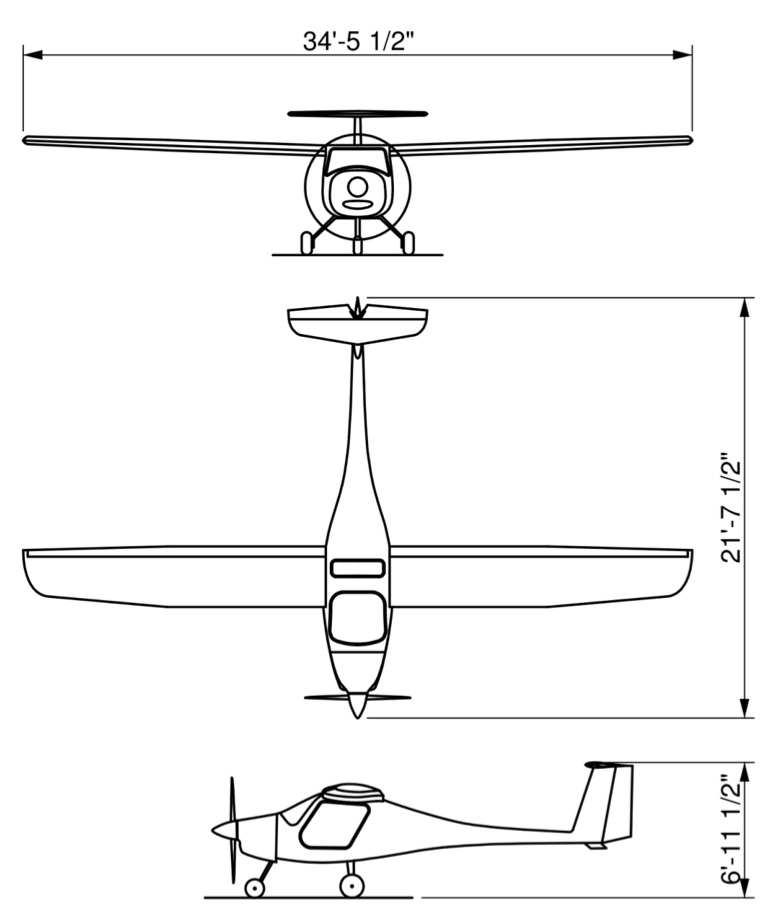
TECHNICAL DATA
| model ALPHA TRAINER |
|
| ENGINE ROTAX | ROTAX 912 UL |
| max power(with 2 carb.) | 80 hp at 5800 rpm |
| PROPELLER | Fixed pitch wooden 63"/ 1620 mm diameter propeller with protected leading edge |
| SIZES | |
| wing span | 34,4 ft (10,5 m) |
| length | 21.33 ft (6.5 m) |
| height | 6.07 ft (2.05 m) |
| wing area | 96.6 sq.ft (9.51 m2) |
| rudder area | 11.8 sq.ft (1.1 m2) |
| tail area | 11.6 sq.ft (1.08 m2) |
| aspect ratio | 11,3 |
| positive flaps | 0°, 15°, 25° |
| center of gravity | 20% - 38% MAC |
| WEIGHTS | |
| empty weight | 615 lbs (279 kg) |
| empty weight light version | 1212 lbs (550 kg) |
| max take off weight (MTOW) | 507 lbs (230 kg) |
| fuel tanks capacity | 13,2 US gal (50 l) |
| useful fuel | 12,7 US gal (48 l) |
| PERFORMANCES | DATA PUBLISHED FOR TOM of 472.5 kg, All speeds in Knots |
| stall with flaps | 37 kts |
| stall without flaps | 43 kts |
| cruising speed (75% power) | 108 kts |
| max. horizontal speed | 120 kts |
| VNE | 135 kts |
| max speed with flaps down | 70 kts |
| manoeuvring speed | 86 kts |
| best climb speed | 75 kts |
| max climb rate ( 450 kg) | 1,220 fpm |
| best glide ratio speed | 64 kts |
| best glide (prop. 90 deg.) | 15:1 |
| take off run ( 450 kg) | 459 feet |
| take off over 15 m obstacle (450 kg) | 738 feet |
| service ceiling ( 450 kg) | 18,000 feet |
| 45° - 45° roll time | 2,6 sec |
| fuel consum. at cruis. speed | 3.6 US gph (13.6 lph) |
| endurance (std tanks) | 3,1 hours |
| range distance | 324 NM (600 km) |
| max load factor permitted ( x 1,8) | +4 g - 2 g |
| design safety factors & tested | minimum 1.875 |
Pipistrel reserves the right to revise the above data whenever occasioned by product improvement, government/authority regulations or other good cause. The design basis follow the strictest EASA CS-22, CS-VLA and CS-23 (sections), as well as rules applicable to ultralight/microlight aircraft (LTF-UL 2003, etc.) and ASTM-LSA standards.
Ultralight/Microlight certification basis varies from country to country, therefore the actual certificated data may be different from stated above. Please check the certifications link.